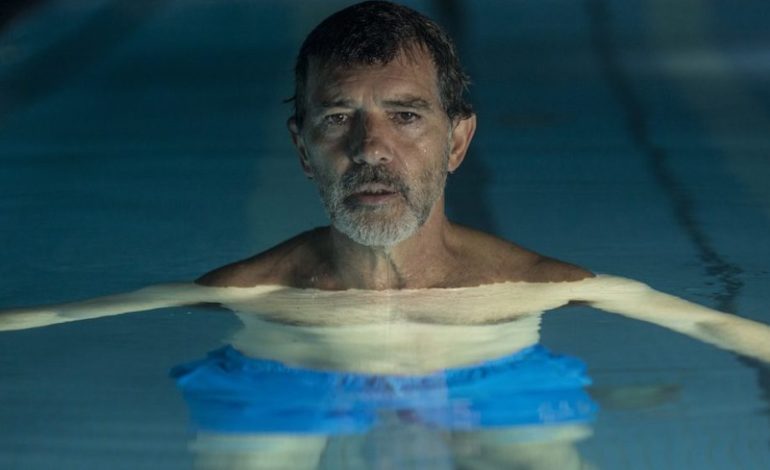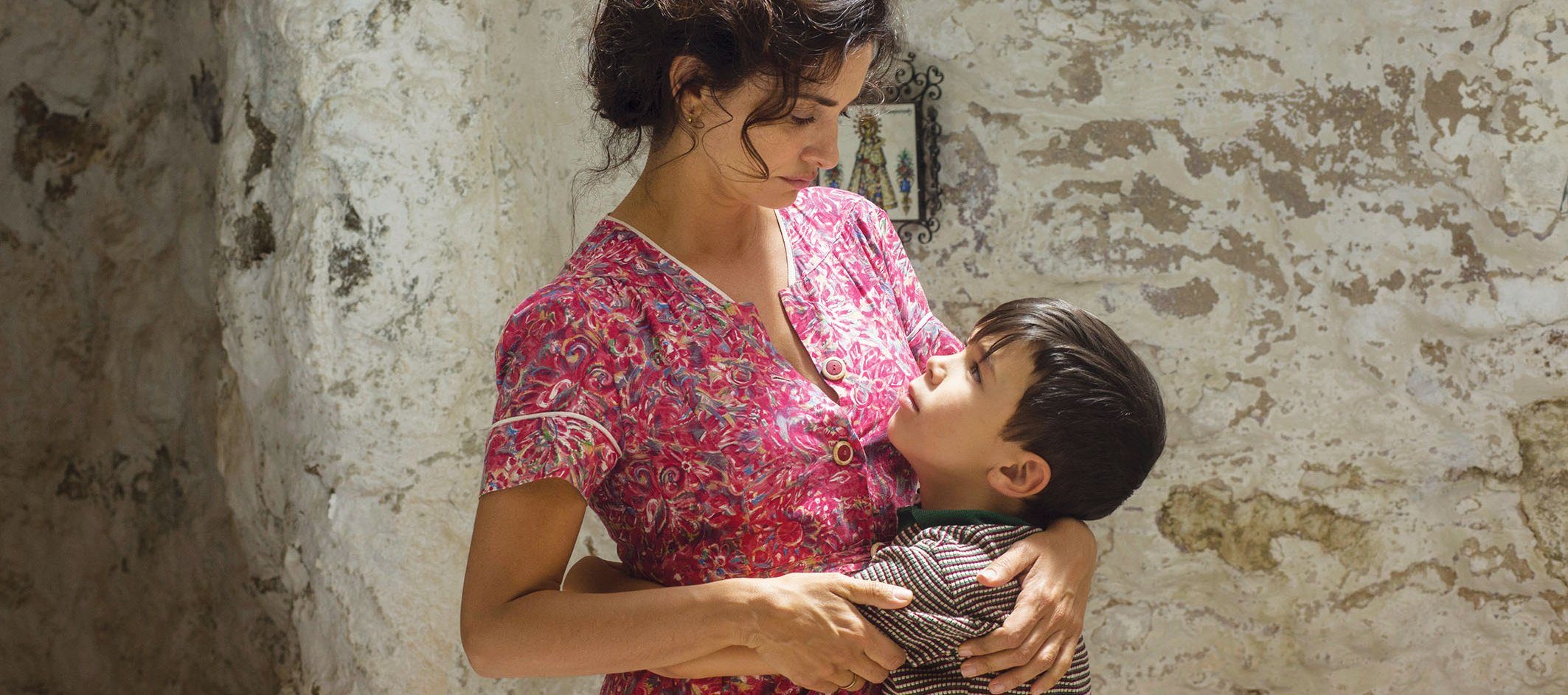

The opening credits of Pedro Almodóvar’s Pain and Glory are surrounded by warping, kaleidoscopic patterns that look like a cross between marbled paper and Magic Eye illustrations. They are vibrant and dreamy, a bit like the world protagonist Salvador Mallo (Antonio Banderas) lives in. The film always shows Salvador surrounded by bright color, whether it be his clothing, home decor, or natural surroundings. The colors of his life swirl together as he phases between reality and memory. The same goes for sounds, smells, and sensations; the first scene shows Salvador submerged in a swimming pool, recalling childhood days of playing in streams as his mother Jacinta (Penélope Cruz) and her friends do laundry. One shade, sound, smell, or touch can bend time and bring the past into the present. This is a movie about memory.
From our first sighting of Banderas’ hair, which resembles Almodóvar’s fuzzy curls, it becomes clear that Pain and Glory’s writer/director is not shying away from the meta. Salvador is a dwindling filmmaker with an exhausting list of physical ailments, many of which Almodóvar suffers from himself. With this in mind, the aforementioned marbled designs also feel anatomical, like watching cells under a microscope or the twisting sinews of a muscular diagram, much artsier expressions than the more clinical graphics used by Almodóvar to outline Salvador’s health issues.


Salvador narrates that, while he had no formal education in anatomy or geography due to a push toward music, he learned the former through his own afflictions and the latter through his travels as a filmmaker. Learning through lived experience, and then tracing those lessons sensually—even by literally charting them on the body via injuries and scars—are two of the film’s central ideas. Pain and Glory is not an exercise in nostalgia or regret, or a simple ponderance on memory. Instead, it asks what we do with our memories, or what we make of them… which, in the case of Almodóvar and Salvador, is art.
As I mentioned, the emotional time-travel Salvador undergoes throughout the film is often triggered by some particular sensation, such as the sound bridge between the hotel piano player in Salvador’s present and the choir director in his past. However, when Salvador begins experimenting with heroin—with the guidance of Alberto Crespo (Asier Etxeandia), an actor who starred in one of his films thirty years ago—no such bridges are necessary. Salvador simply slips into a memory, like falling asleep. While he lies in this “groggy” state, Alberto sneaks a peek at some of Salvador’s writings. By convincing him to turn his work into a one-man play, Alberto helps Salvador take the first step in working through his past. However, Salvador still wants no connection to the play whatsoever.
Salvador spends a lot of time lying around his house, doing more heroin and playing back memories like home movies in his head, leaving him with much free time to focus on his ailments to the concern of his assistant Mercedes (Nora Navas). Salvador’s home is bright and beautiful, but he is still left with an overwhelming sense of emptiness. In general, the film’s glossy exterior is often mismatched against melancholy undertones. When the Guggenheim asks to borrow two of Salvador’s paintings, he refuses, explaining that they are his only companions. At the doctor’s office where Salvador confronts his health problems, the walls are backlit with gaudy imitations of nature scenes, complete with a blue sky on the paneled ceiling. This is a callback to the open skylight in Salvador’s home as a young boy in the ‘60s.
It seems ironic that the place Salvador was at his happiest was that near-colorless, whitewashed cave in which he and his mother lived in Paterna, a small village in Valencia. While their first sight of the cave upset his mother, it delighted young Salva’s childlike disposition. His optimism allowed him to gaze up at the barred hole in their ceiling with wonder, while his mother just saw it as another obstacle.


When Jacinta mentions the hole’s unfortunate tendency to let in rain, the village’s “Pious Woman” scolds her ungratefulness and asks her to consider how important rain is to farmers and their crops. This is a key argument of the film; those obstacles are necessary for growth. When Federico (Leonardo Sbaraglia)—an ex-lover and ex-heroin addict from Salvador’s life in the ‘80s—asks if the pain he put him through stifled any creative abilities, Salvador says no—it was just the opposite. Salvador becomes more at peace as he learns to process his trauma rather than shut it away. He uses them as kindling for his art, just as Almodóvar does himself. This is emphasized at the end of the film, in an interesting twist that breaks the fourth wall in more ways than one.
My only qualm with Pain and Glory is that, at times, I could feel its 113-minute run time. However, I can see why it competed for the Palme d’Or at Cannes, and why Banderas was awarded Best Actor. He and Almodóvar are long-time collaborators, so it’s fascinating to see Banderas play somewhat of a cinematic mirror image of the director. Alberto Iglesias clearly won the Cannes Soundtrack Award for a reason, as the music in the film tugs at the heartstrings perfectly. The appearance and musical feature by Spanish pop sensation Rosalía was a pleasant surprise, as well. All performances were convincing and, even with Cruz’s stunning looks, I was able to suspend my disbelief and accept her as the village beauty. This was largely made possible through the wonderful costuming. Joseé Luis Alcaine’s cinematography deserves much credit as well, with all its lush, crisp shots which effortlessly transported me to towns of dust and clay.
Verdict: 4 out of 5 Stars
Although it feels a little long, Pain and Glory is a worthwhile experience. Its examination of memory, desire, pain, and family will likely make you recall moments from your own childhood—the best and the worst—and consider how they made you who you are today.
